Soil Fertility and Carbon Stock Variability for Defining Management Zones in Tropical Agricultural Systems
Abstract
1. Introduction
2. Materials and Methods
2.1. Study Area Characterization
2.1.1. Description of the Evaluated Production Systems
2.1.2. Definition of Sampling Points
- Cstock: soil carbon stock (Mg ha−1),
- OC: soil organic carbon content (g kg−1),
- Dsoil soil bulk density (kg dm−3),
- E: layer thickness (cm).
- Msoil: soil mass per hectare (Mg ha−1),
- Ds: soil bulk density (Mg m−3),
- L: thickness of the evaluated layer (m).
2.2. Soil Sample Preparation and LIBS Analysis
2.2.1. Soil Collection
2.2.2. Soil Sample Preparation for LIBS Analysis
2.3. Reference Method for the LIBS System
2.4. Evaluated Soil Fertility Parameters
2.5. Development of Soil Fertility and Soil Carbon Stock Maps
2.5.1. Application of Fuzzy Logic to Interpolated Soil Fertility and Soil Carbon Stock Maps
2.5.2. Overlay of Soil Fertility Maps
2.5.3. Creating Management Zones Through Reclassification of Soil Fertility and Soil Carbon Stock Maps
2.5.4. Conversion of Raster Maps to Vectors (Polygons)
2.6. Analysis Method for Soil Fertility and Soil Carbon Stock Maps
2.7. Statistical Analyses
Pearson Correlation
3. Results
3.1. Analysis of Soil Chemical Properties for Different Uses and Managements
Analysis of Soil Carbon Stocks for Different Uses and Managements
3.2. Interpolated and Normalized Maps of Soil Fertility and Soil Carbon Stock
3.2.1. Soil Fertility Overlay Map
3.2.2. Soil Carbon Stock
3.3. Analyses
Pearson Correlation
3.4. Relationships Between the Soil Fertility Map and the Soil Carbon Stock Map
4. Discussion
5. Conclusions
Author Contributions
Funding
Data Availability Statement
Acknowledgments
Conflicts of Interest
Abbreviations
| CEC | Cation Exchange Capacity |
| EM | Eucalyptus Monoculture |
| GHC | Greenhouse Gas |
| GIS | Geographic Information Systems |
| IPF | Livestock-Forestry Integration |
| LIBS | Laser-Induced Breakdown Spectroscopy |
References
- IPCC (Intergovernmental Panel on Climate Change). Relatório Síntese do Sexto Relatório de Avaliação (AR6): Mudança do Clima 2023; IPCC: Genebra, Switzerland, 2023. Available online: https://www.gov.br/mcti/pt-br/acompanhe-o-mcti/sirene/publicacoes/relatorios-do-ipcc/arquivos/pdf/copy_of_IPCC_Longer_Report_2023_Portugues.pdf (accessed on 20 December 2024).
- Gurgel, A.C.; Manzatto, C.V.; Vicente, L.E.; Perosa, B. Agricultura de baixo carbono no Brasil: Desafios para o crédito e monitoramento de emissões. In Proceedings of the 61º Congresso da Sociedade Brasileira de Economia, Piracicaba, Brazil, 23–27 July 2023. [Google Scholar]
- Cunha, E.; Monteiro, J.A.F. Uso de drones na agricultura de precisão. Rev. Bras. Agric. Sustentável 2021, 10, 78–90. [Google Scholar]
- Zimback, C.R.L. Análise Espacial de Atributos Químicos de solos para fins de Mapeamento da Fertilidade. Ph.D. Thesis, Universidade Estadual de São Paulo, Botucatu, Brazil, 2001. [Google Scholar]
- Santos, G.A.; Camargo, F.A.O. Fundamentos da Matéria Orgânica do solo: Ecossistemas Tropicais & Subtropicais; Genesis: Porto Alegre, Brazil, 2019. [Google Scholar]
- Sano, E.E.; Rosa, R.; Brito, J.L.S.; Ferreira, L.G. Mapeamento Semidetalhado do uso da terra do Bioma Cerrado; Embrapa Cerrados: Planaltina, Brazil, 2008. [Google Scholar]
- Haridasan, M. Nutritional adaptations of native plants of the cerrado biome in acid soils. Sci. Agric. 2000, 57, 631–640. [Google Scholar] [CrossRef]
- Santos, H.G. Sistema Brasileiro de Classificação de Solos, 5th ed.; Embrapa Solos: Brasília, Brazil, 2018. [Google Scholar]
- Lal, R. Managing soil carbon for climate change adaptation and mitigation. Geoderma 2018, 337, 1–10. [Google Scholar]
- Sisti, C.P.J.; Santos, H.P.; Kohhann, R.; Alves, B.J.R.; Urquiaga, S.; Boddey, R.M. Change in carbon and nitrogen stocks in soil under 13 years of conventional or zero tillage in southern Brazil. Soil Tillage Res. 2004, 76, 39–58. [Google Scholar] [CrossRef]
- Claessen, M.E.C. Manual de Métodos de Análise de solo, 2nd ed.; Centro Nacional de Pesquisa de Solos: Rio de Janeiro, Brazil, 1997. [Google Scholar]
- Raij, B.V.; Cantarella, H.; Quaggio, J.A.; Furlani, A.M.C. Recomendações de Adubação e Calagem para o Estado de São Paulo, 2nd ed.; Instituto Agronômico: Campinas, Brazil, 1997. [Google Scholar]
- Filipini, A.L. Modelagem SIG em agricultura de precisão: Conceitos e aplicações. In Agricultura de Precisão: Resultados de um novo Olhar; Bassoi, L.H., Ed.; Embrapa: Brasília, Brazil, 2014. [Google Scholar]
- Martins, F.R. Análise de Dados para Ciências Ambientais: Aplicações e Métodos Estatísticos; Ed. Atlas: São Paulo, Brazil, 2012. [Google Scholar]
- Cohen, J. Statistical Power Analysis for the Behavioral Sciences, 2nd ed.; Lawrence Erlbaum Associates: Hillsdale, MI, USA, 1988. [Google Scholar]
- Dias, F.P.M.; Leandro, W.M.; Xavier, F.A. Phosphorus lability in a Ferralsol as affected by land-use change in the Brazilian Cerrado. Biol. Agric. Hortic. 2025, 41, 35–48. [Google Scholar] [CrossRef]
- Gubiani, T.; Santanna, E.; Veloso, M.A.; Calegari, M.G.; Canalli, A.; Finckh, L.B.d.S.; Caner, M.R.; Rheinheimer, L.; Santos, D. Effect of 26-years of soil tillage systems and winter cover crops on carbon and nitrogen stocks in a southern Brazilian Oxisol. Rev. Bras. Ciênc. Solo 2020, 44, e018. [Google Scholar]
- Bernardi, A.C.d.C.; Bueno, J.O.d.A.; Laurenti, N.; Santos, K.E.L.; Alves, T.C. Effect of lime and fertilizers applied at variable rate on soil chemical attributes and production costs of a Tanzania grass pasture intensively managed. Braz. J. Biosyst. Eng. 2018, 12, 368–382. [Google Scholar] [CrossRef][Green Version]
- Segnini, A.; Xavier, A.A.P.; Otaviani-Junior, P.L.; Oliveira, P.P.A.; Pedroso, A.D.F.; Praes, M.F.F.M.; Milori, D.M.B.P. Soil carbon stock and humification in pastures under different levels of intensification in Brazil. Sci. Agric. 2019, 76, 33–40. [Google Scholar] [CrossRef]
- Favoretto, C.M.; Gonçalves, D.; Milori, D.M.B.P.; Rosa, J.A.; Leite, W.C.; Brinatti, A.M.; Saab, S.C. Determination of humification degree of organic matter of an Oxisol and of its organic mineral fractions. Química Nova 2008, 31, 1994–1996. [Google Scholar] [CrossRef]
- Bayer, C. Estabilização do carbono no solo e mitigação das emissões de gases de efeito estufa na agricultura conservacionista. In Tópicos em Ciência do solo; Klauberg Filho, O., Ed.; Sociedade Brasileira de Ciência do Solo: Viçosa, Brazil, 2011. [Google Scholar]
- Souza, Z.M.; Marques Júnior, J.; Pereira, G.T.; Barbieri, D.M.; Montanari, R. Lógica fuzzy na avaliação da fertilidade do solo e produtividade do café conilon. Rev. Ciênc. Agron. 2010, 41, 1–9. [Google Scholar]
- Moreira, F.M.S.; Siqueira, J.O. Microbiologia e Bioquímica do Solo, 2nd ed.; UFLA: Lavras, Brazil, 2006. [Google Scholar]
- Raij, B.V. Fertilidade do solo e Manejo de Nutrientes; Instituto da Potassa e Fosfato: Piracicaba, Brazil, 2011. [Google Scholar]
- Malavolta, E. Manual de Nutrição Mineral de Plantas; Agronômica Ceres: São Paulo, Brazil, 2006. [Google Scholar]
- Raij, B.V. Fertilidade do solo e Manejo de Nutrientes; Instituto Agronômico: Piracicaba, Brazil, 1997. [Google Scholar]
- Souza, E.D. Efeito do manejo de pastagens na dinâmica do carbono do solo. Rev. Bras. Geogr. Física 2019, 12, 1–14. [Google Scholar]
- Carvalho, J.L.N. Dinâmica do carbono em solos manejados sob diferentes sistemas de uso. Rev. Bras. Ciênc. Solo 2017, 41, 1–10. [Google Scholar]
- Costa, F.S. Sequestro de carbono em sistemas integrados de produção agropecuária. Pesqui. Agropecuária Bras. 2020, 55, 1–12. [Google Scholar]
- Silva, A.C. Impacto da silvicultura no sequestro de carbono em diferentes tipos de solo. Ciênc. Florest. 2018, 28, 1–15. [Google Scholar]
- Fisher, R.A. Statistical Methods for Research Workers, 14th ed.; Oliver and Boyd: Edinburgh, Scotland, 1992. [Google Scholar]
- Siegel, S.; Castellan, N.J. Nonparametric Statistics for the Behavioral Sciences, 2nd ed.; McGraw-Hill: New York, NY, USA, 1998. [Google Scholar]
- Tabachnick, B.G.; Fidell, L.S. Using Multivariate Statistics, 5th ed.; Pearson: Boston, MA, USA, 2007. [Google Scholar]
- Donagema, G.K.; Santos, H.G.; Montanari, R. Manual de Métodos de Análise de Solo, 2nd ed.; Embrapa Solos: Rio de Janeiro, Brazil, 2011. [Google Scholar]
- Salton, J.C.; Mielniczuk, J.; Bayer, C. Teores e estoques de carbono e nitrogênio no solo em sistemas agropecuários do Mato Grosso do Sul. Rev. Bras. Ciênc. Solo 2010, 34, 1759–1773. [Google Scholar]
- Ribeiro, J.M.; Frazão, L.A.; Cardoso, P.H.S.; Oliveira, A.L.G.; Sampaio, R.A.; Fernandes, L.A. Fertilidade do solo e estoques de carbono e nitrogênio sob sistemas agroflorestais no Cerrado Mineiro. Ciênc. Flor. 2009, 29, 913–923. [Google Scholar] [CrossRef]
- Machado, P.L.O.A.; Bernardi, A.C.C.; Silva, C.A. Agricultura de Precisão para o Manejo da Fertilidade do solo em Sistema Plantio Direto, 1st ed.; Embrapa: Rio de Janeiro, Brazil, 2004. [Google Scholar]
- Sousa, S.S.; Moreira, S.G.; Castro, G.F. Avaliação da fertilidade do solo por Agricultura de Precisão e Convencional. Rev. Agrogeoamb. 2016, 8, 33–46. [Google Scholar] [CrossRef]
- Troian, D.; Rosset, J.S.; Martins, L.F.B.N.; Ozório, J.M.B.; Castilho, S.C.P.; Marra, L.M. Carbono orgânico e estoque de carbono do solo em diferentes sistemas de manejo. Rev. Agroneg. Meio Ambiente 2020, 13, 1447–1469. [Google Scholar] [CrossRef]
- Ronquim, C.C. Conceitos de Fertilidade do solo e Manejo Adequado para as Regiões Tropicais, 2nd ed.; Embrapa Territorial: Campinas, Brazil, 2020. [Google Scholar]
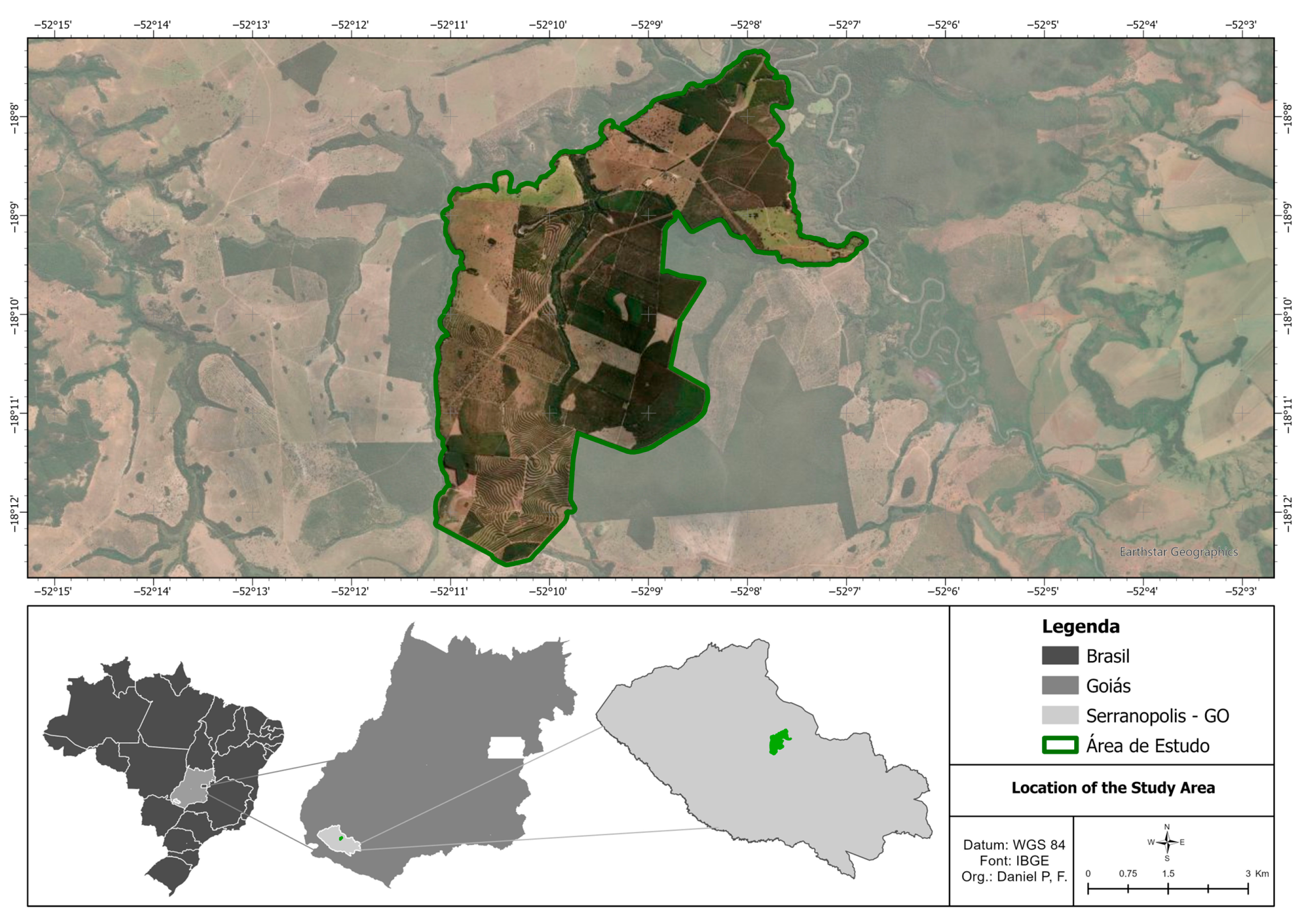
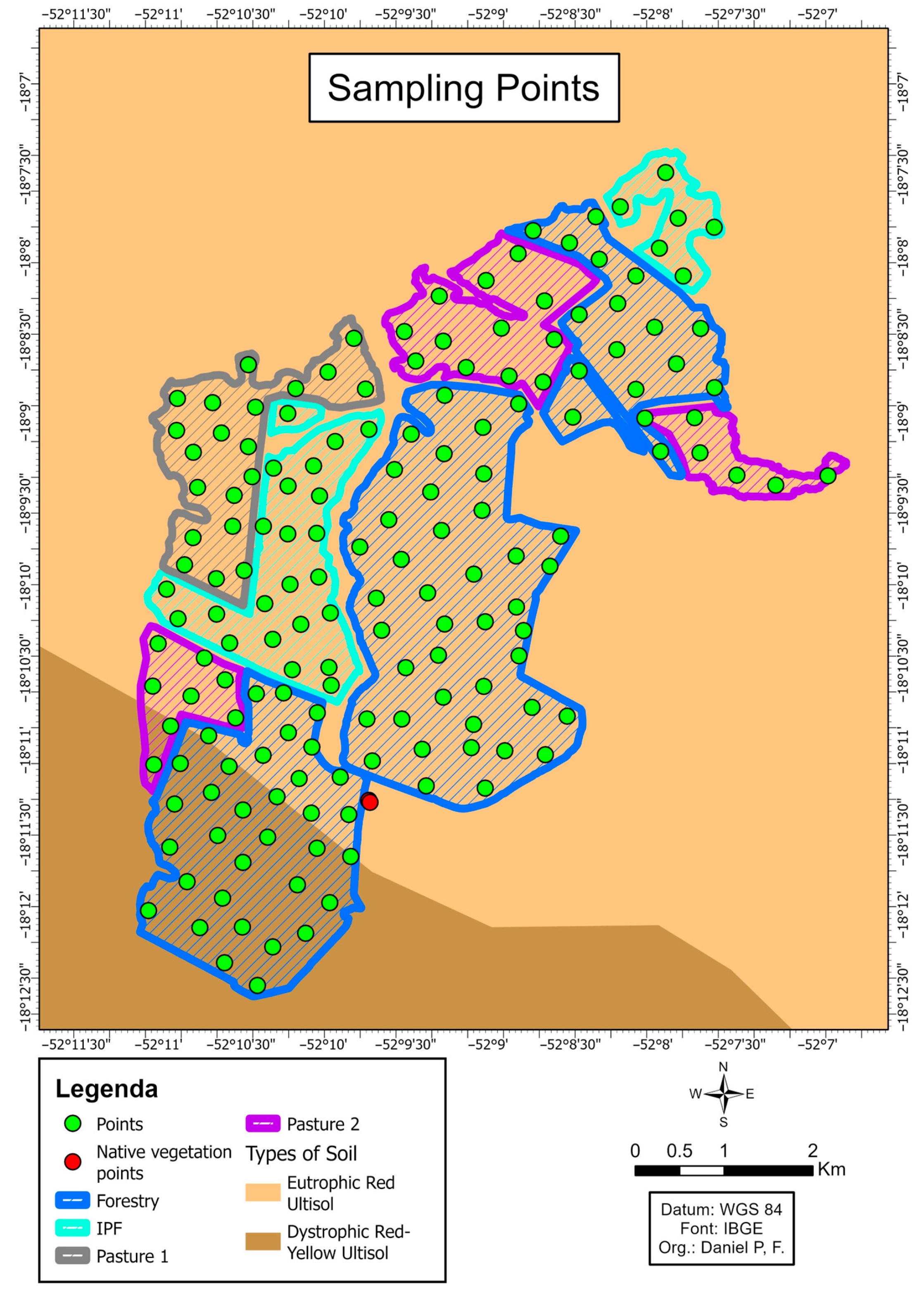
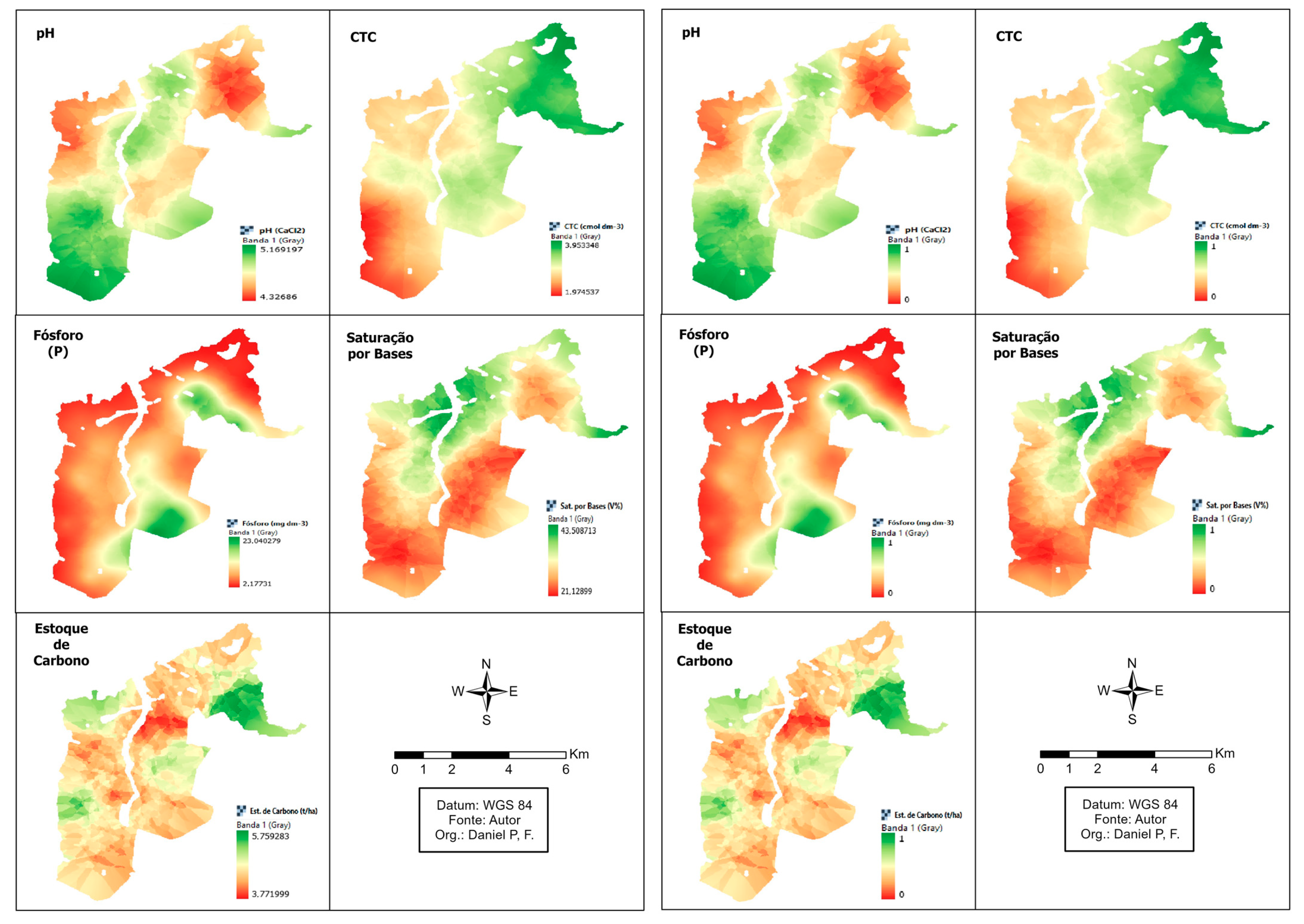
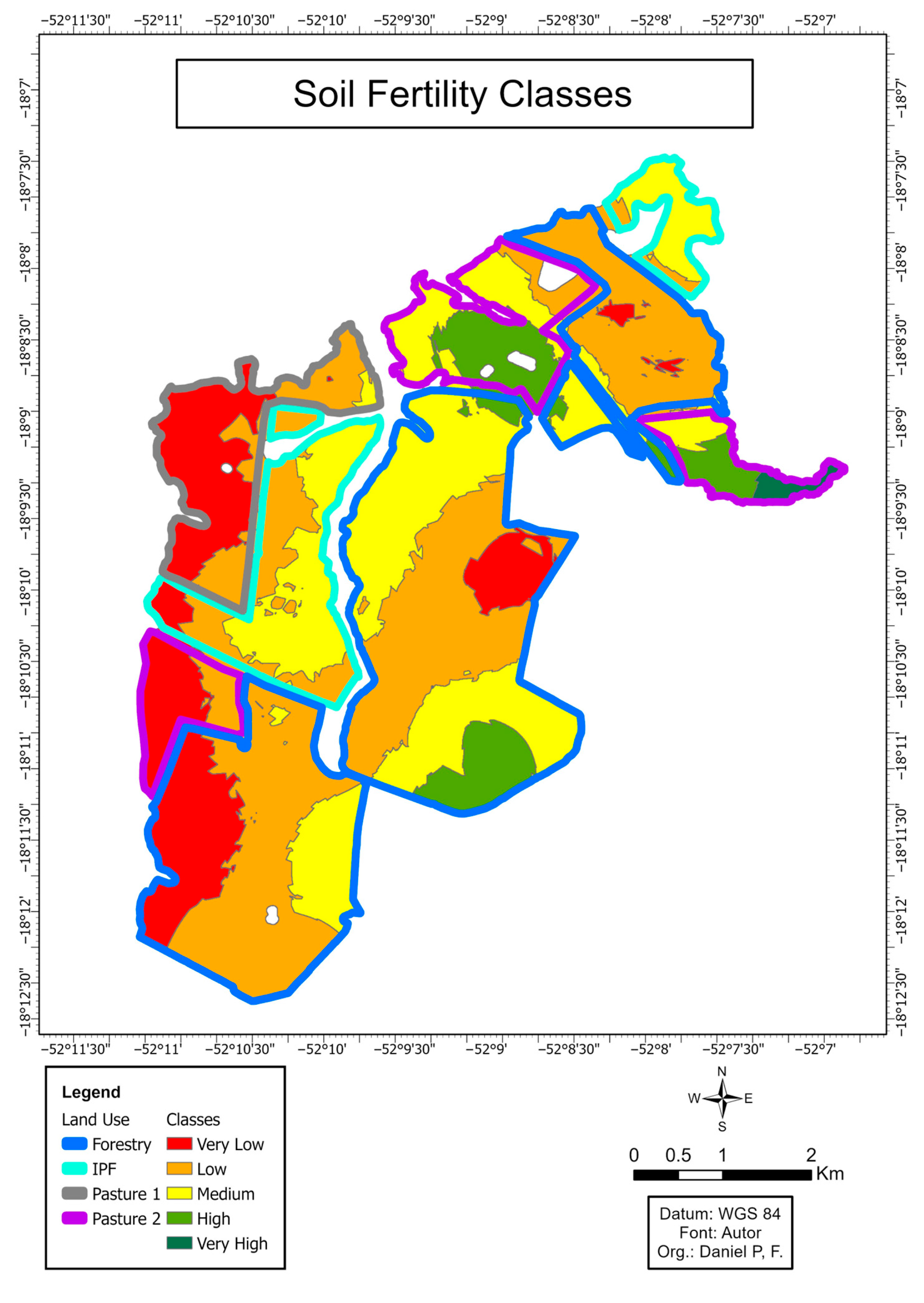
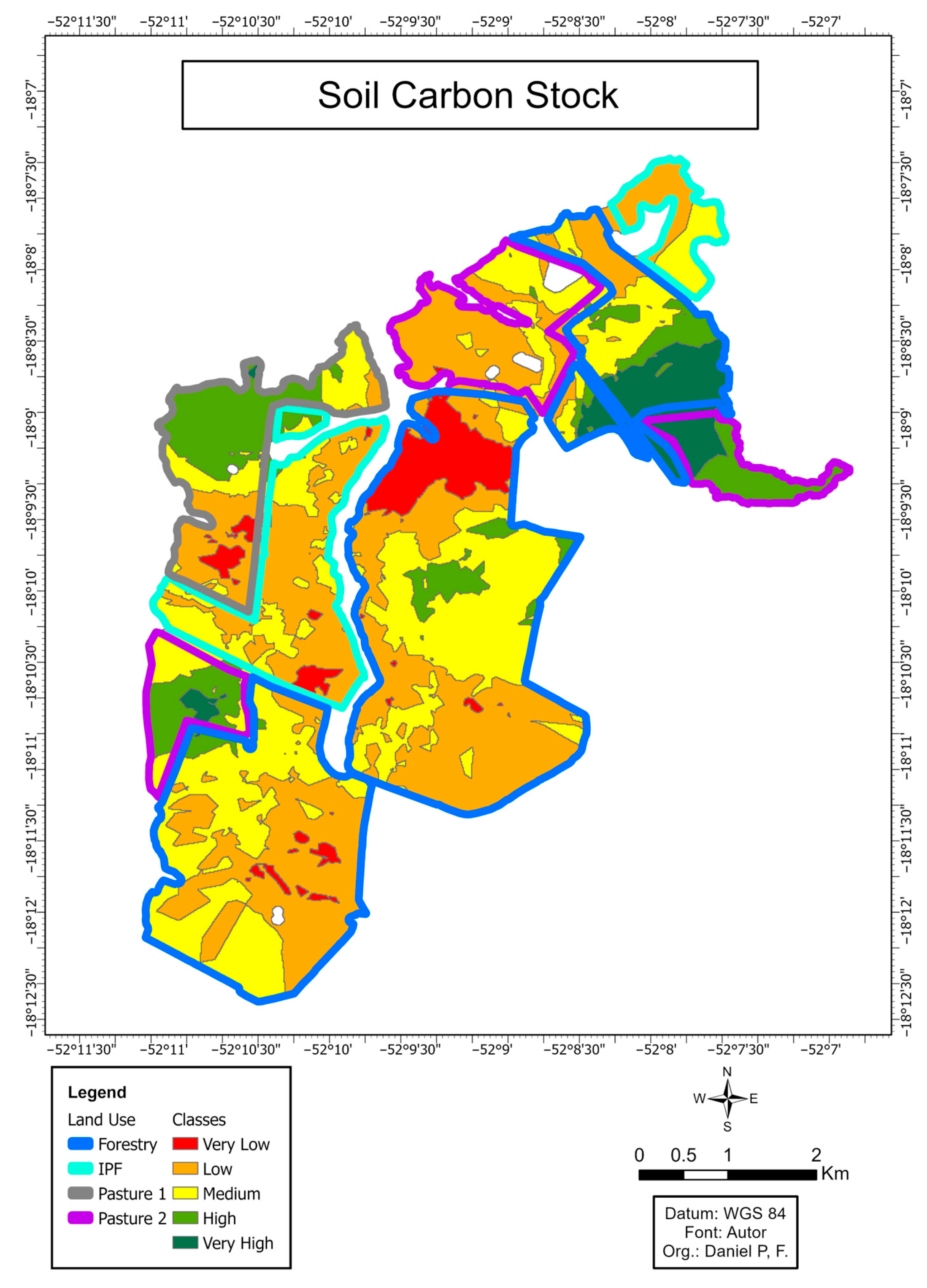

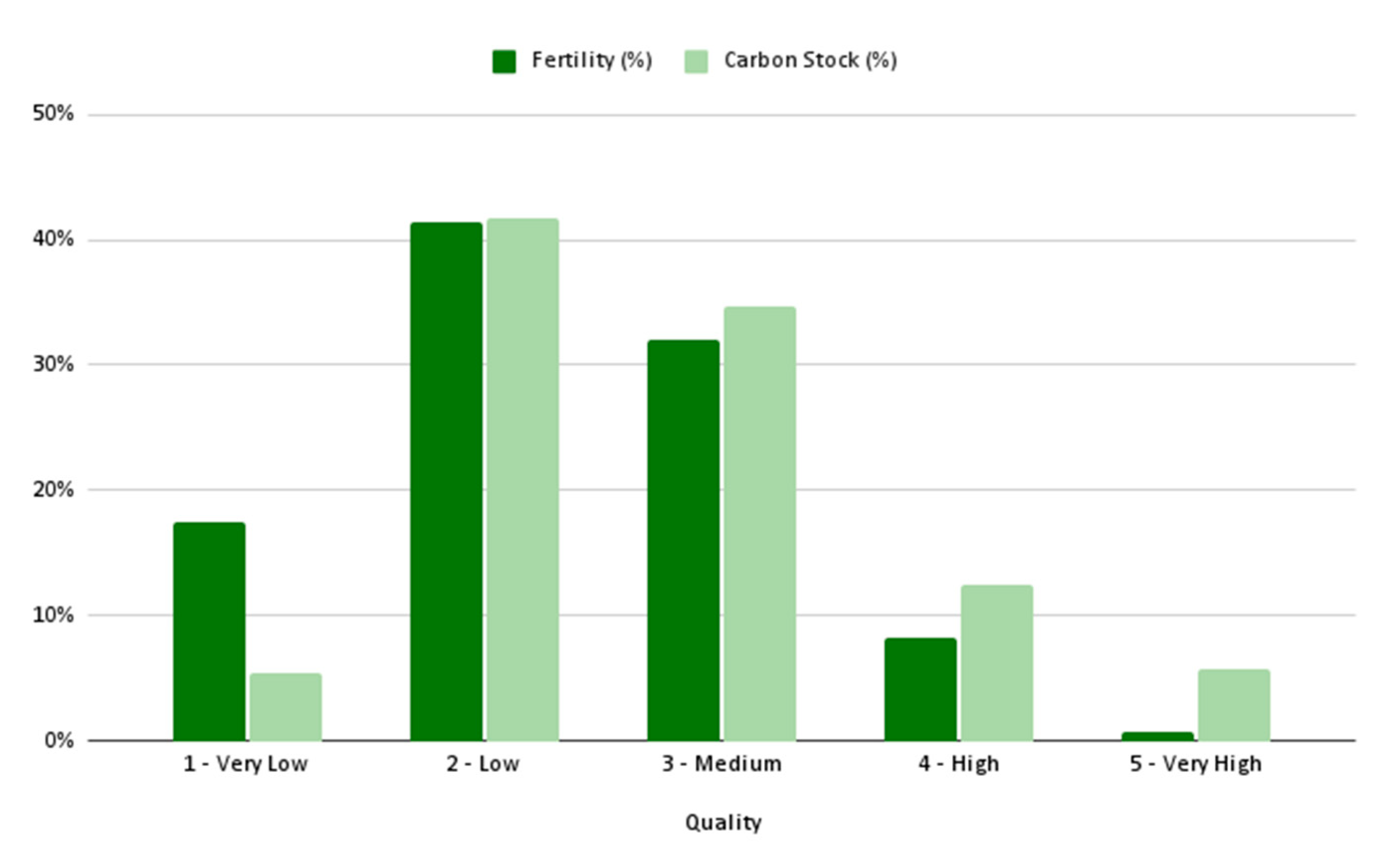
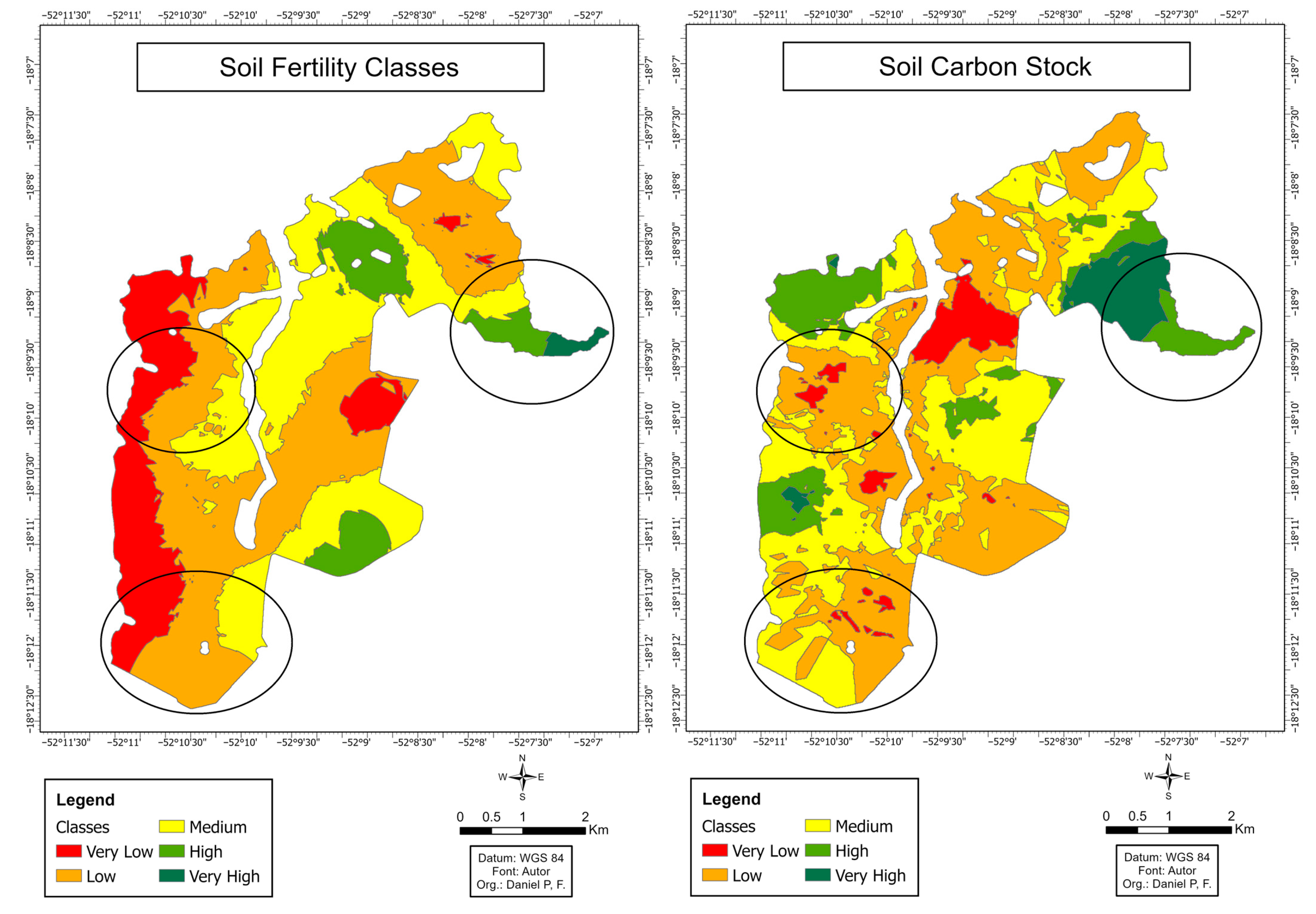
| Class | Value |
|---|---|
| Very Low | 0 to 0.2 |
| Low | 0.2 to 0.4 |
| Medium | 0.4 to 0.6 |
| High | 0.6 to 0.8 |
| Very High | 0.8 to 1 |
| Class | Area (ha) |
|---|---|
| Very Low | 519.64 |
| Low | 1233.07 |
| Medium | 952.58 |
| High | 245.89 |
| Very High | 21.57 |
| Class | Area (ha) |
|---|---|
| Very Low | 162.11 |
| Low | 1238.25 |
| Medium | 1031.18 |
| High | 368.92 |
| Very High | 171.09 |
Disclaimer/Publisher’s Note: The statements, opinions and data contained in all publications are solely those of the individual author(s) and contributor(s) and not of MDPI and/or the editor(s). MDPI and/or the editor(s) disclaim responsibility for any injury to people or property resulting from any ideas, methods, instructions or products referred to in the content. |
© 2025 by the authors. Licensee MDPI, Basel, Switzerland. This article is an open access article distributed under the terms and conditions of the Creative Commons Attribution (CC BY) license (https://creativecommons.org/licenses/by/4.0/).
Share and Cite
Daniel Filho, P.; Barretto de Figueiredo, E. Soil Fertility and Carbon Stock Variability for Defining Management Zones in Tropical Agricultural Systems. AgriEngineering 2025, 7, 308. https://doi.org/10.3390/agriengineering7090308
Daniel Filho P, Barretto de Figueiredo E. Soil Fertility and Carbon Stock Variability for Defining Management Zones in Tropical Agricultural Systems. AgriEngineering. 2025; 7(9):308. https://doi.org/10.3390/agriengineering7090308
Chicago/Turabian StyleDaniel Filho, Paulo, and Eduardo Barretto de Figueiredo. 2025. "Soil Fertility and Carbon Stock Variability for Defining Management Zones in Tropical Agricultural Systems" AgriEngineering 7, no. 9: 308. https://doi.org/10.3390/agriengineering7090308
APA StyleDaniel Filho, P., & Barretto de Figueiredo, E. (2025). Soil Fertility and Carbon Stock Variability for Defining Management Zones in Tropical Agricultural Systems. AgriEngineering, 7(9), 308. https://doi.org/10.3390/agriengineering7090308






